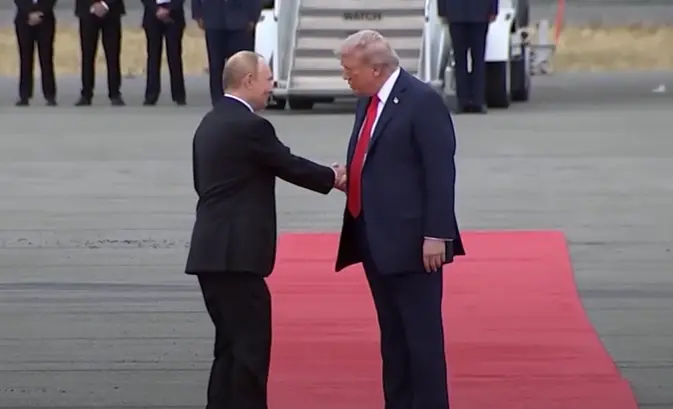
Double-Dealing Diplomacy: U.S. Rewards Russia, Slaps Tariffs on India
A Tale of Two Partners: Uneven Trade Treatment Unfolds
Trade Double Standards – In a surprising revelation during a joint press conference in Alaska, Russian President Vladimir Putin announced that U.S.-Russia bilateral trade has surged by 20% since the Trump administration took office. The announcement raised eyebrows globally, not just for the numbers, but for the timing, coming amid ongoing U.S. tariffs on India for its energy dealings with Russia.
This juxtaposition has reignited debate over the consistency and fairness of U.S. trade policy. While India faces economic penalties for purchasing Russian oil, Russia itself enjoys growing trade relations with the United States. The optics are jarring: one nation punished for engaging with Russia, while the other benefits directly from it.
The discrepancy points to a deeper issue, how strategic interests, political alliances, and economic leverage shape trade decisions more than stated principles of fairness or reciprocity.
India’s Tariff Troubles: Punished for Pragmatism
India’s decision to purchase Russian energy was driven by economic necessity. With global oil prices soaring and domestic demand rising, Russian crude offered a lifeline, affordable, accessible, and available. Yet, this pragmatic move drew sharp rebuke from Washington.
The Trump administration responded with targeted tariffs on Indian goods, citing violations of sanctions and undermining Western efforts to isolate Moscow. Indian officials, however, argued that their energy policy was non-aligned and based on national interest, not ideological allegiance.
The tariffs have had tangible consequences:
- Export Slowdown: Indian textile and pharmaceutical exports to the U.S. declined by nearly 15% in the first quarter of 2025.
- Investor Anxiety: Uncertainty over trade relations has dampened foreign direct investment in key Indian sectors.
- Diplomatic Strain: The move has cooled bilateral enthusiasm, with New Delhi calling for “transparent and equitable” trade rules.
India’s frustration is not just economic, it’s philosophical. As the world’s largest democracy and a strategic U.S. partner, India expected more nuanced engagement, not punitive measures.
Russia’s Quiet Gains: Trade Growth Amid Isolation
While India faces tariffs, Russia appears to be quietly thriving in its trade relationship with the U.S. Despite sanctions and diplomatic tensions, bilateral trade has grown, particularly in non-energy sectors like agriculture, metals, and technology components.
Putin’s announcement of a 20% increase in trade was not just a statistic, it was a statement. It signalled that Russia, despite being cast as a global pariah, still finds economic pathways through strategic diplomacy and selective partnerships.
Several factors explain this growth:
- Backchannel Agreements: Certain U.S. companies have maintained limited trade under humanitarian or non-sanctioned categories.
- Commodity Demand: Russia’s raw materials remain essential for global supply chains, especially in aerospace and manufacturing.
- Political Calculus: The Trump administration’s transactional approach to foreign policy often prioritized economic benefit over ideological consistency.
This rise in trade undermines the narrative of total isolation and raises questions about the effectiveness and sincerity of U.S. sanctions.
Double Standards or Strategic Flexibility? Parsing the Policy
The contrasting treatment of India and Russia reveals a complex web of strategic interests, economic priorities, and political messaging. Critics argue that the U.S. is applying double standards, rewarding Russia with trade growth while penalizing India for similar engagements.
Supporters of the administration claim it’s a matter of strategic flexibility: Russia’s trade is carefully curated, while India’s energy purchases directly fund Moscow’s war chest. But this distinction is murky at best, especially when trade data shows significant U.S. imports from Russian firms with indirect ties to state enterprises.
The broader implications are troubling:
- Credibility Crisis: Allies may begin to question the reliability and fairness of U.S. trade commitments.
- Policy Confusion: Mixed signals weaken the impact of sanctions and embolden adversaries.
- Global Rebalancing: Countries like India may seek alternative alliances, reducing U.S. influence in key regions.
Ultimately, the issue isn’t just about tariffs or trade, it’s about trust. If the U.S. wants to maintain its leadership in global commerce, it must reconcile its policies with its principles.
Conclusion: Rethinking Trade in a Multipolar World
The rise in U.S.-Russia trade amid tariffs on India exposes a fault line in American trade diplomacy. It’s a reminder that in a multipolar world, consistency matters more than ever. Allies like India expect fairness, not favouritism. And adversaries like Russia exploit ambiguity to their advantage.
As global dynamics shift, the U.S. must decide: will it lead with principle or pivot with convenience? Because in the court of global opinion, double standards don’t just hurt trade they erode influence.
Defiant Allies: Russia and India Challenge Trump’s Tariff Threat
Stay updated with latest updated news blogs on Rapido Updates.